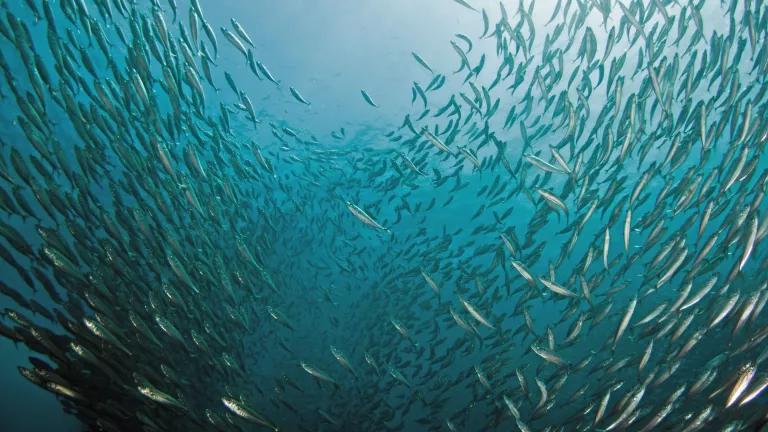New England Ocean Monument: A Model for Ocean Climate Action
The IPCC’s upcoming report will detail the severe consequences of climate change for the ocean, animal and plant species, and the human race.

Shortfin squid and a monkfish in Oceanographer Canyon.
NOAA, Deep Connections 2019
Three years ago, the U.S. Atlantic Ocean got its first marine national monument: the Northeast Canyons and Seamounts off the coast of New England. President Obama designated this spectacular deepsea area as a monument on September 15, 2016. Think about this monument when you hear the findings of the Intergovernmental Panel on Climate Change (IPCC) next Wednesday. Protecting this marine area is precisely the kind of action we need to take to avert the worst impacts of climate change. We need to do it on a larger scale, and fast.
The IPCC is set to issue a Special Report on the Ocean and Cryosphere in a Changing Climate on September 25th. You may recall recent IPCC reports (one last fall on Global Warming of 1.5°C and a recent one Climate Change and Land) that sent shockwaves around the world. This one is likely to do the same with alarm bells sounding for our oceans.
The report will detail the first-ever global scientific consensus on the severe consequences of climate change for the ocean, the millions of animal and plant species that inhabit it, and ultimately, the human race. The ocean supplies our food, supports coastal economies, regulates weather and climate, buffers our shorelines from storms, and serves as a place of inspiration and wonder. Climate change jeopardizes virtually everything the ocean does for humankind. We are already witnessing adverse impacts that will increase in severity, including: rising sea levels, coastal flooding, harmful water temperatures, lower dissolved oxygen levels, and a more acidic ocean. All of this will critically threaten ocean wildlife, driving marine species into extinction in unprecedented numbers. Just this summer, scientists alerted us to the biodiversity crisis that is already underway, with one million species confronting extinction, in significant part because of climate change.
We can and must respond to this crisis.
First and foremost, we need to substantially reduce greenhouse gas emissions, especially CO2, which causes ocean acidification.
Another thing we must do is implement adaptation strategies to increase ocean resiliency to the unavoidable impacts of climate change. This should include strongly protecting at least 30% of the ocean in areas where marine wildlife can thrive. The Canyons and Seamounts is exactly such an area. But it is barely a start—there are no other strongly-protected ocean areas this size off the continental United States (and the Canyons and Seamounts is only about 1.5% of the U.S. Atlantic).
We need many more of our ocean’s most ecologically-important areas protected in the same way that the Canyons and Seamounts is.
Last week, the NOAA vessel Okeanos Explorer took four exploratory dives in the Northeast Canyons and Seamounts. The agency’s first exploration of the monument post-designation revealed the new and unexpected, as well as the jaw-droppingly beautiful.
On September 4, NOAA dove in the monument’s Oceanographer Canyon where scientists found never-before-seen geological formations, rare starfish species, and a host of other fish and invertebrates.
On September 9-10, after waiting for the remnants of Hurricane Dorian to pass through the region, NOAA explored the previously unvisited eastern slope of Bear Seamount and southeast slope of Retriever Seamount, where they found a tremendous diversity and abundance of sponges, including glass sponges, vase sponges, demosponges, and several potential new species, as well as many corals, including bamboo corals more than 2 meters long. An octopus making a seafloor stroll on Bear Seamount was a particular crowd favorite.

Graneledone verrucosa octopus on Bear Seamount. NOAA, Deep Connections 2019.

Unknown sponge on Retriever Seamount. NOAA, Deep Connections 2019.
The final dive in the monument used a series of transects north of Bear Seamount to explore the midwater, the area of the ocean between the bottom and surface layers, that makes up the world’s largest biome. Although bad weather limited the dive, we saw a massive chimaera, different species of bioluminescent ctenophores, including one that expedition scientists had never seen before, hydromedusa and other jellyfish, copepods, and sawtooth eels.

Large Chimaera near Bear Seamount. NOAA, Deep Connections 2019.
The marine life is just as exciting at the monument’s surface. On August 30th, an aerial survey by the New England Aquarium’s Anderson Cabot Center for Marine Life observed 878 dolphins and 27 whales, including sperm and pilot whales, in under four hours within the monument. This is the latest in the New England Aquarium's seasonal aerial surveys of the monument that have documented an astonishing diversity and abundance of marine mammals there.

Sperm Whale in the Canyons and Seamounts Monument. New England Aquarium.
The marine life in these photographs live in a rapidly-warming ocean. And the IPCC report will describe the fallout of our climate crisis on creatures like these—and the effects on all of us.
We all depend on healthy oceans.
We will need the wisdom of the IPCC’s report—and more—if we want our oceans to continue to feed us, to serve as home to charismatic wildlife, and to support our cultural and spiritual well-being.




